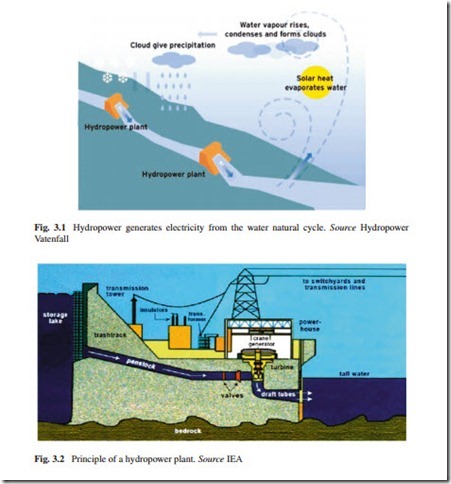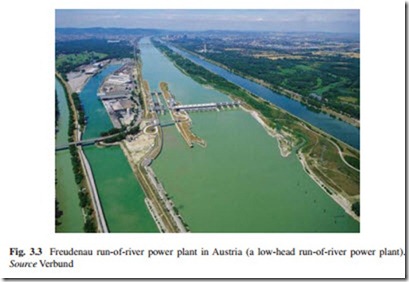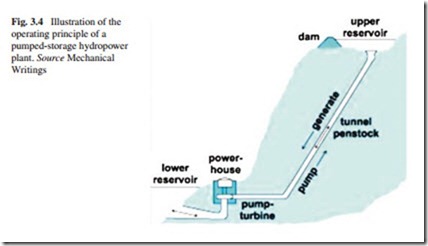Abstract Hydropower is the major renewable generation technology in Europe today. It delivers storage capacity and stabilizing services for the power system, which are crucial for a high security of supply of electricity. No doubt, hydro- power is a mature and cost-competitive renewable energy source and a key component of the energy mix in several EU countries, and it plays a key role in today’s electricity mix in other regions of the world as well. As a multi-functional technology, it is indispensable to the electricity system and will be even more important tomorrow, particularly, when other fossil fuels used today for the generation of electricity will not be sufficient to satisfy the foreseeable energy demand during the coming decades. The importance of a generation technology for the overall system depends mainly on its capability to stabilize fluctuations between demand and supply. Hydropower already contributes to balancing these differences—a function that will be even more valuable in the future.
Introduction
Hydropower dates back more than 2000 years to when the Greeks used water wheels to grind grain. Over the centuries, it has played an important role in pro- viding mechanical energy and, more recently, electricity, supporting human and economic development. In India, during the Roman Empire and in ancient China, water wheels were built to operate mills and timber saws. Hydropower was devel- oped over the centuries and was used in the early industrial era to power spinning machines and looms in textile factories in England and other countries. But mod- ern, large-scale hydropower as is known it today first came into being with the invention of the electric motor and the electric generator.
Hydropower is the major renewable generation technology in Europe today. It delivers storage capacity and stabilizing services for the power system, which are crucial for a high security of supply of electricity. No doubt, hydropower is a mature and cost-competitive renewable energy source and a key component of the energy mix in several EU countries, and it plays a key role in today’s electricity mix in other regions of the world as well. As a multi-functional technology, it is indispensable to the electricity system and will be even more important tomorrow, particularly, when other fossil fuels used today for the generation of electricity will not be sufficient to satisfy the foreseeable energy demand during the coming decades.
The importance of a generation technology for the overall system depends mainly on its capability to stabilize fluctuations between demand and supply. Hydropower already contributes to balancing these differences—a function that will be even more valuable in the future. When assessing the future of hydropower utilization in Europe, two basic influencing factors must be distinguished:
• A change in exploitable river flow, mainly induced by climate change;
• A change in the existing hydropower installed capacity in the individual countries. Undoubtedly, in Europe, hydropower is the main renewable electricity generation source (69 %), followed by wind (15 %), primary solid biomass (7 %), municipal waste (4 %), biogas (3 %), solar (1 %), and geothermal (1 %) power generation (RESAP 2011).
It is important to highlight that hydropower production varies from year to year, depending on the hydrological situation. In 2008, the total EU-27 hydropower pro- duction was 352 TWh according to Eurostat statistics. Large-scale hydropower dominates with a production of 296 TWh in 2010, while small-scale hydropower production was 45 TWh; in total in 2010, hydropower generated 341 TWh. In 2011, the total electricity generated by hydropower reached 347 TWh an increase of 1.8 % with respect to 2010. In 2012, the total electricity generated in the European region using hydropower plants was 588.968 billion kWh; this represents an increase of 4.3 % with respect to the level reached in 2008.
In addition to the hydrological situation, the role of hydropower within the different national electricity generation portfolios varies greatly according to geo- graphical conditions, climate, precipitation patterns, the availability of affordable energy supply alternatives, as well as institutional capacities and technical competences. Some countries have abundant water resources, which they use almost exclusively for their domestic electricity generation (e.g., Norway and Albania). Other countries do not have the required natural conditions and thus have very little or practically no hydropower production or potential (e.g., Denmark, Belgium, and the Netherlands) (RESAP 2011).
Types of Hydropower Plants
Hydropower plants convert the kinetic energy contained in falling water into electricity. The energy in flowing water is ultimately derived from the sun and is there- fore constantly being renewed. The energy contained in sunlight evaporates water from the oceans and deposits it on land in the form of rain. Differences in land elevation result in rainfall runoff and allow some of the original solar energy to be captured as hydroelectric power (see Fig. 3.1).
Hydroelectric power plants can be classified according to the way they make use of the inflow that they receive, depending on whether this cumulative flow must be used within a short period of time or whether it can be retained for a certain time period (UCTE 2000). The classification applied in this book distinguishes between run-of-river power plants, pondage and reservoir power plants, and pumped power plants.
The principles under which a hydropower plant operates are shown in Fig. 3.2. Hydroelectric power plants can also be divided, based on the operational mode,
into run-of-river and reservoir (pondage, reservoir, and pumped) power plants. Run-of-river power plants use the flow of water from upstream without any substantial storage. This may be a natural flow or flow determined by other water use upstream. Run-of-river power plants use the flow of water within a river’s natural range. This type of hydropower plant show fluctuations in energy production induced by low flow or overflows periods, whereas reservoir power plants can store water (i.e., energy) over long time periods and generate a steady supply of electricity, relatively independent from variations in short-term inflows (Lehner et al. 1998).
The electricity output of a run-of-river power plant depends on the availability of water in the river and varies considerably throughout the year. Seasons, rainfall, or snowmelt all influences the amount of water available for electricity generation. Because they lack storage, run-of-river powers plants operate under the constraint of precisely controlling the water level at the intake in accordance with the incoming river flow. Run-of-river hydropower plants without connection to upstream storage typically operate as base-load power plants since the hydrological forecast is sufficiently good for the timescales required in the electricity market (RESAP 2011).
Upstream hydropower plants or reservoirs have to be taken into consideration when looking at the energy output of a run-of-river power plant (see Fig. 3.3). A constant output from a run-of-river hydropower plant is possible, if the river is already regulated further upstream by a hydropower plant with storage capacity (thanks to the reservoir). A commonly used strategy to optimize the energy output of hydropower plants on a river is to build a large storage reservoir in the upper catchment, which will even outflows for several run-of-river or smaller reservoir plants downstream. Beyond the energy storage function of reservoir plants,
regulating a river in the upper area of a river basin with a reservoir will increase the energy potential of sites downstream, as the regulated river will typically flow more evenly throughout the year. Multiple run-of-river power plants can be developed downstream of a reservoir-type hydropower plant. That way, water is “reused” to produce additional electricity as it flows down the same river. The combined cascade of dams and reservoirs allows an optimized electricity generation and may also be used to absorb excess energy when reducing river flow, thereby strongly enhancing the storage function from the upper reservoir.
Pumped-storage facilities use excess electrical system capacity, generally avail- able at night, to pump water from one reservoir to another reservoir at a higher elevation. During periods of peak electrical demand, water from the higher reservoir is released through turbines to the lower reservoir, and electricity is produced. Although pumped-storage sites are not net producers of electricity—it actually takes more electricity to pump the water up than is recovered when it is released— they are a valuable addition to electricity supply systems. Their value is in their ability to store electricity for use later when peak demands are occurring. Storage is even more valuable, if intermittent sources of electricity, such as solar or wind, hook into a system.
With regard to pumped-storage hydropower plants, it is important to highlight the following: In the EU, electricity generation from pumped-storage hydropower plants is not considered as renewable, since pumping the water up consumes electricity produced by other power plants in the grid and pumped-storage power plants thus become net energy consumers (see Fig. 3.4). In fact, more electric- ity is needed to pump water from the lower to the upper reservoir than is generated when water is released from the upper reservoir into the lower one (overall efficiencies are in the range between 70 and 75 %). However, this drawback is compensated for by the flexibility these plants can provide. Pumped-storage power plants are important to optimize the operation of the conventional thermal generation fleet. As pumped-storage power plants cover peak demand situations
while consuming electricity in periods of lower demand, they allow thermal power plants to stay connected and generate electricity even when demand is low. Through this optimization effect, pumped-storage power plants also contribute to reducing greenhouse gas emissions from thermal power plants, as they need not deviate from the most efficient load. The role of pumped-storage hydropower plants is twofold: Balancing the grid for demand-driven fluctuations and balancing generation-driven fluctuations—a new and increasingly important role due to the increase of renewables in the electricity system (RESAP 2011).
Finally, it is important to highlight the following: Like a conventional reservoir- type hydropower plants, pumped-storage power plants can provide the full range of grid-stabilizing services, thanks to their ability to follow demand or generation fluctuations within only a few minutes. Therefore, storage hydropower is a key tool for TSOs to maintain a stable and balanced grid.


